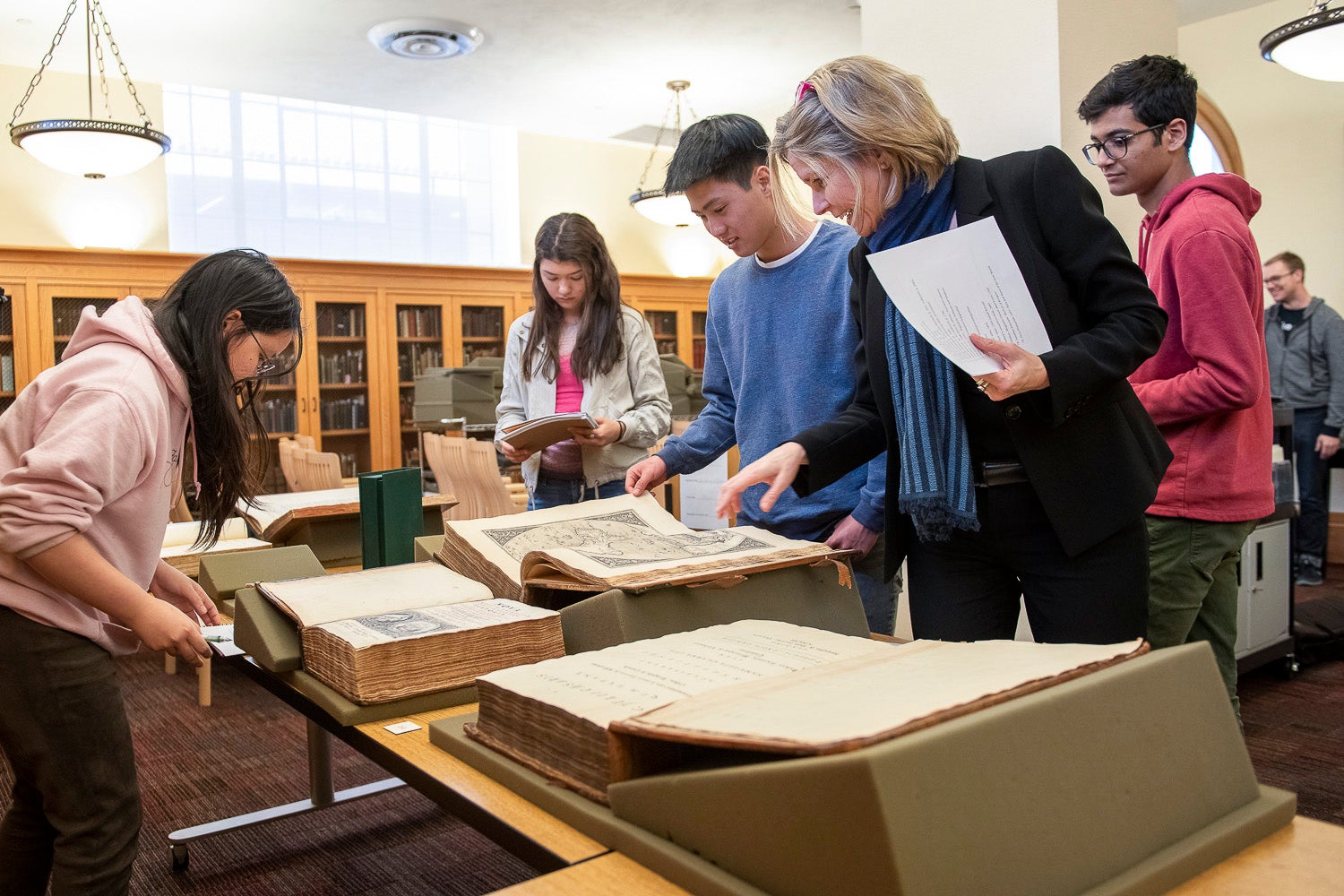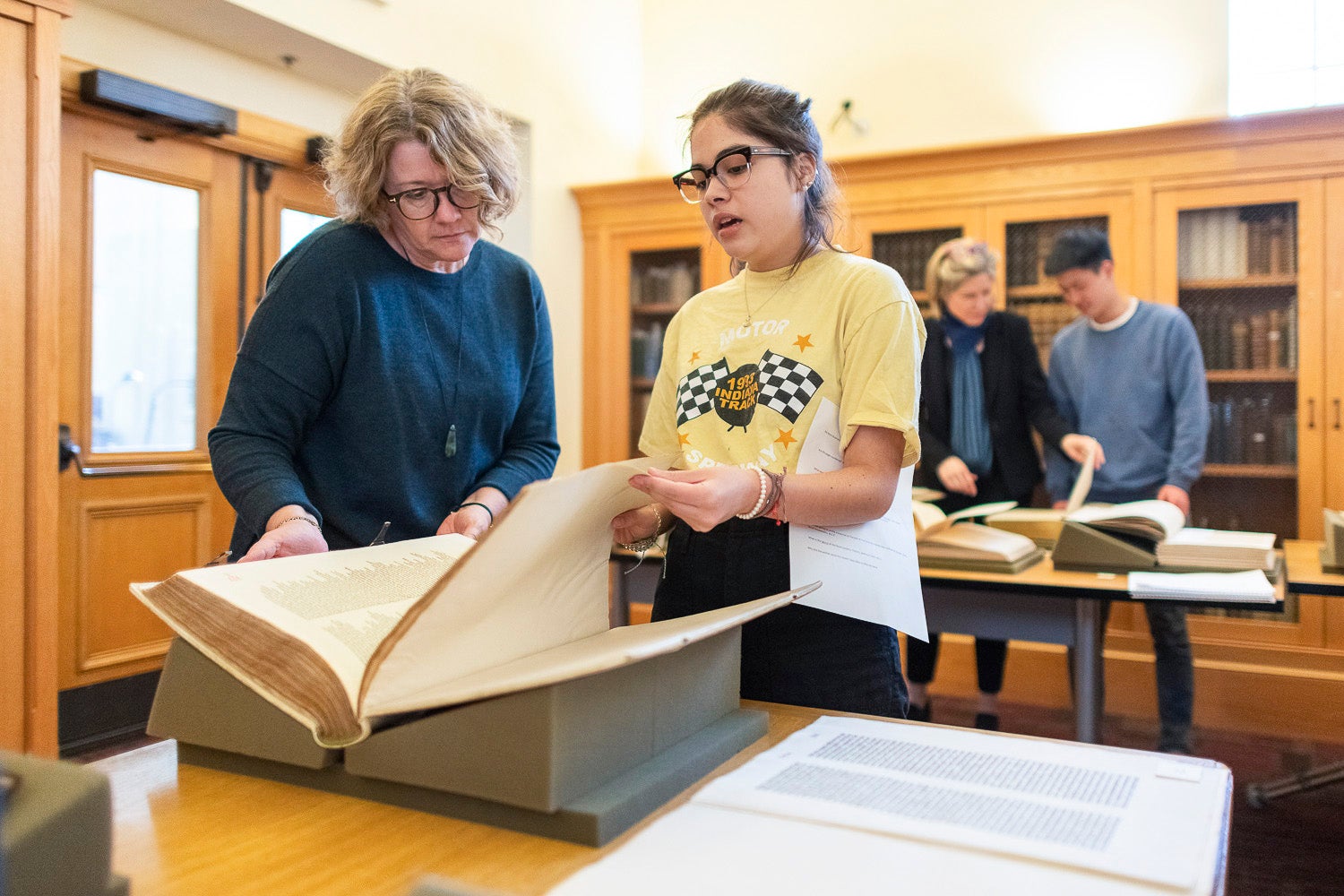Students learn about humanities research through hands-on discovery
A new one-week course, called Humanities Research Intensive, teaches first- and second-year undergraduate students what research in the humanities could be and what skills are needed to do it.
One Monday afternoon during spring break, a group of 15 Stanford first- and second-year undergraduate students gathered around dozens of archival books and texts, some of which were around 800 years old, on the second floor of the Green Library.
Go to the web site to view the video.
The students examined the ancient treasures as part of the new one-week course Humanities Research Intensive, created by the Stanford School of Humanities and Sciences and the Stanford Humanities Center. The course will be repeated this coming academic year.
The inaugural group of Humanities Research Intensive fellows learned what it takes to do research in the humanities under the direction of Stanford historian Caroline Winterer and manuscript scholar Elaine Treharne.
“We took the students through the entirety of the humanities research process in miniature,” said Winterer, a professor of history, the Anthony P. Meier Family Professor in the Humanities and director of the Stanford Humanities Center. “Over five days, we taught them how to ask a research question, how to find scholarly literature and how to produce a project proposal.”
A unique research opportunity
Humanities Research Intensive is aimed at first- and second-year undergraduate students who are interested in the humanities, which is the study of how people process and document the human experience, involving fields like philosophy, literature, religion, art, music, history and language.

History Professor Caroline Winterer and Humanities Research Intensive students examine archival treasures in the Special Collections reading room at Green Library. (Image credit: L.A. Cicero)
The course is the brainchild of Treharne and Winterer, who proposed its creation to introduce students to what research in the humanities could be and what skills are needed to do it.
The course is designed to be equivalent to the opportunities that students majoring in the sciences get during their first years at Stanford.
“Undergraduates pursuing STEM majors have a considerable number of opportunities as early as their first freshman quarter for developing their research through lab work or internships. But the humanities students don’t really have access to the same opportunities until later in their academic career,” said Treharne, professor of English, the Roberta Bowman Denning Professor in the School of Humanities and Sciences and director of Stanford Text Technologies.
Treharne said that it is important to introduce students to humanities research, which is often misunderstood.
“People often think that humanities research is comprised of getting some books of poetry and reading them, but that’s only one kind of humanities research,” Treharne said. “There is actually a tremendous amount of excitement to be generated about the relics of the past which human endeavor has produced. Archival research is about being able to contextualize, read and describe objects and put them into a broader social and cultural set of significances, often by using digital tools and approaches, too.”
An archival “petting zoo”
On the first day of the five-day course, instructors took the students to the Special Collections department at Green Library. There, the students were greeted with five tables filled with 43 books and objects – representing some of the best archival treasures that Stanford has.

English Professor Elaine Treharne works with undergraduate Lore Olivera. (Image credit: L.A. Cicero)
Among them were colorful medieval manuscripts, such as a 13th-century French portable Bible written on animal skin, and more modern, famous texts, such as a copy of John Milton’s Paradise Lost signed by both Thomas Jefferson and James Madison.
“What we did was similar to a petting zoo for little kids – we let the students have direct contact with the things that we want them to learn about,” Winterer said.
Students were given a couple of hours to look at the materials and pick an object that interested them. They then had to come up with a research question about the object and write a five-page proposal for a research project by the end of the week.
For example, Arman Kassam, one of the students, examined a 17th-century book about the coronation of King James II of Britain. He became curious when he saw mangoes on the menu of items served at the feast. His question was: How did a mango end up on the table of King James II when England’s colonization of India was only beginning? Kassam traced the trade connections between different parts of the world in the 17th century as part of his final proposal.
Aside from Green Library, the students also visited the Hoover Institution Library and Archives, which contain documents related to war, revolution and peace in the 20th and 21st centuries. There, curators assembled a table filled with powerful historical materials, including Adolf Hitler’s daily briefing and an X-ray of Hitler’s skull as well as the piece of paper that issued the order to drop the nuclear bombs on Hiroshima and Nagasaki.
For Treharne, that moment was one of the most powerful ones during the entire week.
“I said to the students, ‘Can you imagine the human impact of these pieces of paper on this one table?’” Treharne said. “And there was an absolutely resounding silence. They had learned how ephemera like these diaries and papers can have an incredible significance for the human experience.”
An enlightening experience
Freshmen Lena Han and Arman Kassam said they applied to be Humanities Research Intensive fellows because they wanted to experience what humanities research is and if it was something they could pursue in the future.
“The Humanities Research Intensive gives Stanford students the opportunity to work closely with some of our leading faculty so they can learn what it means to conduct research in the humanities and advance our knowledge and understanding of the world.”
—R. Lanier Anderson
Senior Associate Dean for the Humanities and Arts, School of Humanities and Sciences
Han said she was interested in art, politics and other humanities fields, but she never had an opportunity to do any intense research on her own. Kassam said he has previously done research in the sciences but was confused about what methods people in the humanities used in their projects.
Han examined an immigration pamphlet from 1876 that included a testimony by an attorney about Chinese immigrants. She noticed that rhetoric that seemed biased toward the Chinese, so she decided to analyze the pamphlet and compare it to others made during later time periods.
“The experience has been really informative in terms of making research more accessible,” Han said. “We learned a lot about how to interact with primary sources and how to develop research questions out of our own interests.”
Both Han and Kassam said their favorite part of the course was interacting with students, as well as with Winterer and Treharne.
“Stanford has top-ranked departments in the humanities and arts,” said R. Lanier Anderson, senior associate dean for the humanities and arts in the School of Humanities and Sciences and the J. E. Wallace Sterling Professor in the Humanities. “The Humanities Research Intensive gives Stanford students the opportunity to work closely with some of our leading faculty so they can learn what it means to conduct research in the humanities and advance our knowledge and understanding of the world. We are really indebted to professors Treharne and Winterer for designing this innovative program and giving our students such a terrific beginning research experience.”
Humanities Research Intensive occurred during spring break in March 2019. It is scheduled to repeat during spring break in 2020.
